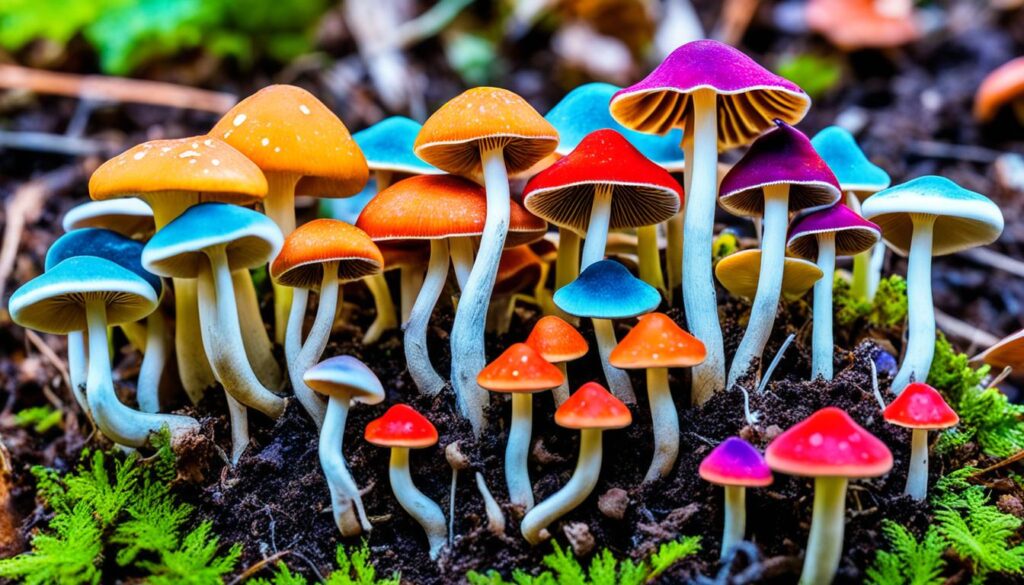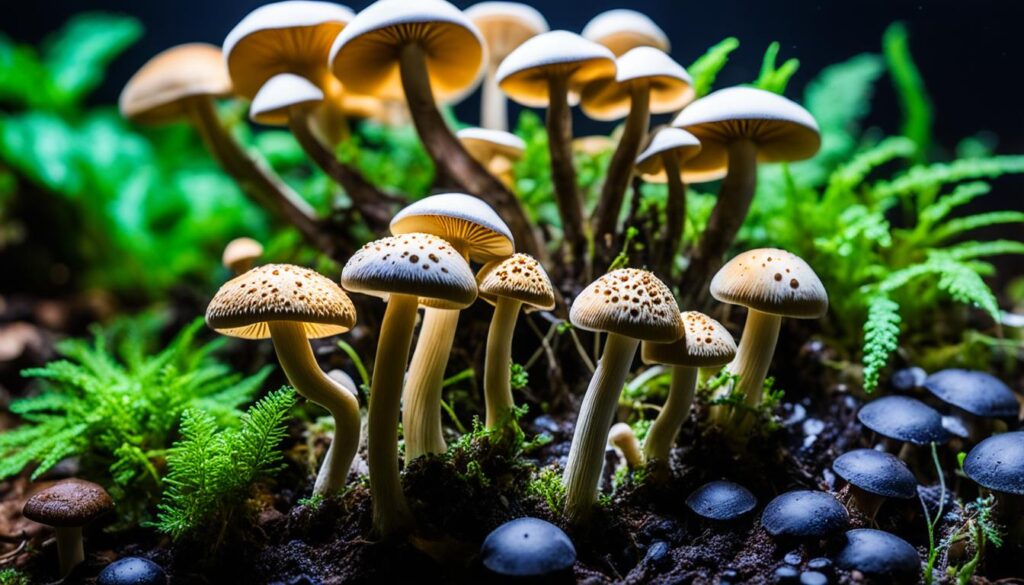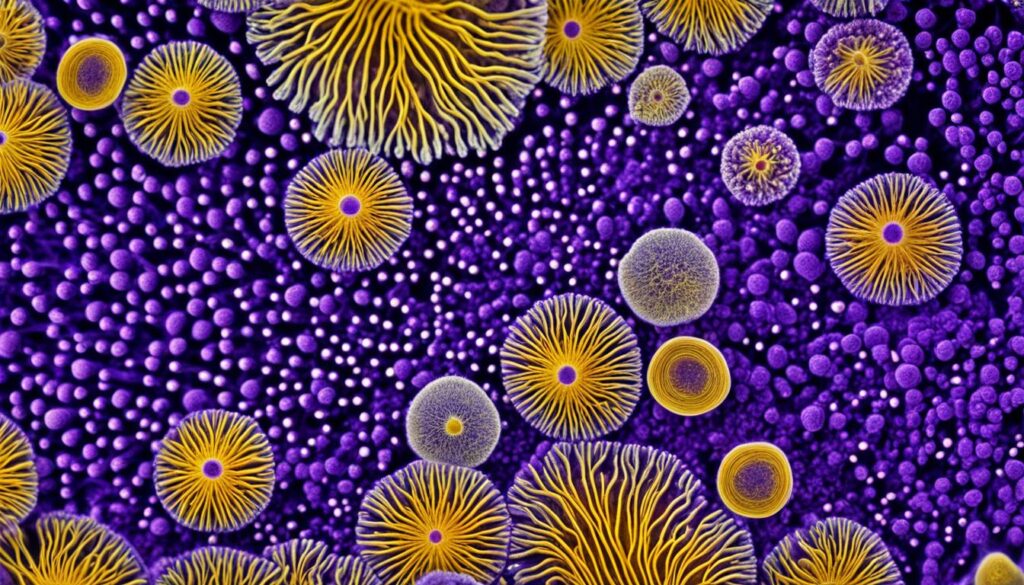The world of psilocybin spores is both fascinating and complex. It has a rich history and ongoing research on their potential benefits. Psilocybin mushrooms, also known as “magic mushrooms,” are a diverse group of fungi. They contain the psychoactive compounds psilocybin and psilocin1.
These compounds can cause visual and auditory hallucinations. They also lead to anxiety, fear, nausea, and muscle twitches1. In Canada, the production, sale, and possession of psilocybin and psilocin are banned, except for some cases1. Yet, interest in their therapeutic uses keeps growing1.
As research on psilocybin mushrooms grows, it’s key to know the facts and uses of these spores. This article will cover their history, legality, how to grow them, and their potential health benefits. It aims to give a full view for those intrigued by this topic.
Introduction to Psilocybin Spores
Psilocybin spores are key to growing psychedelic mushrooms. They carry the active compounds psilocybin and psilocin2. Found on the mushroom cap’s gills or pores, these spores can be used to grow new mushrooms2. Knowing about psilocybin spores helps us understand their history, legal status, and possible health benefits.
What are psilocybin spores?
Psilocybin spores are tiny reproductive parts of psilocybin mushrooms2. They carry the genes needed for new mushrooms to grow3. Spores can stay dormant for a long time, waiting to grow into mycelium under the right conditions3.
History and cultural significance of magic mushrooms
“Magic mushrooms” have a deep history in Central American cultures3. Ancient rock art and records show they were used in rituals by the Maya and other Mesoamericans3. For ages, people have valued them for their ability to change the mind and bring deep spiritual experiences.
Psilocybin mushrooms mean more than just religious use3. Shamans and healers have used them for healing physical and mental health issues3. Their history and cultural importance keep drawing in researchers, historians, and fans, showing how fascinating these mushrooms are4.
Legal Status of Psilocybin Spores in Canada
In Canada, the legal status of psilocybin spores is complex and changing5. Psilocybin and psilocin, found in “magic mushrooms,” are Schedule I drugs under the 1971 UN Psychotropic Substances Convention5. This makes producing, selling, and having psilocybin mushrooms illegal in Canada6.
But, the laws on psilocybin in Canada are not set in stone6. The government sees the potential health benefits of psilocybin and is looking to balance laws with these benefits6. So, there are some legal ways to get psilocybin, like through clinical trials or special programs6.
- Canada has 69 licence holders to make psilocybin from natural or synthetic sources7.
- Since 2022, 176 Canadians got psilocybin through Health Canada’s Special Access Program7.
- Health Canada approved 78% of psilocybin applications under the Special Access Program7.
Even though psilocybin mushrooms are illegal, some places in Canada let you buy and have Psilocybe spores5. But, growing psilocybin mushrooms is seen as making drugs and is very risky5.
The laws on psilocybin spores in Canada are still changing, showing the ongoing debate on their health benefits and regulation6. As research and public knowledge on psilocybin grow, laws might change to fit these new findings6.
“Psilocybin is a Schedule III substance under the CDSA in Canada, affecting laws on having, selling, and moving it.”6
Identifying Psilocybin Mushroom Species
Exploring the world of psilocybin mushrooms is both exciting and complex. With over 200 species, each with unique traits, knowing how to identify them is key. These mushrooms contain psilocybin, psilocin, baeocystin, and norbaeocystin8.
Common Psilocybin-Containing Mushroom Varieties
The Psilocybe genus is famous for its psilocybin mushrooms. But, these mushrooms can also be found in Inocybe and Panaeolus genera8. Inocybe has mostly poisonous mushrooms8. Panaeolus includes species like Panaeolus cinctulus and Panaeolus cyanescens8. Pluteus has species like Pluteus americanus and Pluteus glaucus8.
In the Psilocybe genus, you’ll find many species. Psilocybe cubensis and Psilocybe cyanescens are well-known8. Psilocybe semilanceata, or Liberty Caps, stand out for their unique traits8.

While psilocybin mushrooms may look similar, it’s vital to identify them correctly. The Inocybe genus has mostly poisonous mushrooms9. So, caution and knowledge are key when dealing with these mushrooms.
“Psilocybin mushrooms were historically used by indigenous populations in the Americas, showcasing a longstanding cultural association with the substance.”9
As laws on psilocybin change, with places like Oregon making it legal9, knowing the rules in your area is important. This includes how to identify, possess, and use psilocybin mushrooms8910.
Cultivation and Growth of Psilocybin Spores
Growing psilocybin mushrooms, also known as “magic mushrooms,” needs specific conditions and a careful process. It starts with the psilocybin spore, which is key to the mushroom’s life cycle.
Requirements for Growing Psilocybin Mushrooms
To grow psilocybin mushrooms, you need to meet certain requirements. First, keep the environment at a steady temperature, around 75 degrees Fahrenheit11. Also, prepare and inoculate the growing medium with psilocybin spores11. These spores will grow into the mycelium, then produce the mushrooms you want11.
Step-by-Step Guide to Cultivating from Spores
Cultivating psilocybin mushrooms from spores is rewarding and educational. Here’s how to start:
- Get a spore syringe or spore print from a trusted source11. Remember to check local laws about growing psilocybin mushrooms.
- Prepare a clean growing medium, like grain or a grow kit, as the instructions say11.
- Put the psilocybin spores into the medium, making sure it’s clean to avoid contamination11.
- Keep the substrate at the best temperature for the mycelium to grow and spread11.
- Start the fruiting process by creating the right conditions, like more humidity and airflow11.
- Watch the mushrooms grow, making sure they get the nutrients and conditions they need11.
- Harvest the mushrooms when they open, and prepare them for use or storage11.
Remember, growing psilocybin mushrooms might be illegal in your area, so know and follow the laws12. It’s important to cultivate responsibly and know what you’re doing for the mushrooms’ safety and quality.
By following these steps and keeping things clean, you can start growing psilocybin mushrooms13. This journey lets you learn about these unique fungi and connect with nature’s diversity.

Microscopy and Spore Prints
Psilocybin spores are tiny units that help mushrooms reproduce. Looking at them with a microscope gives us important insights. Spore prints, made by placing a mushroom cap on paper, let us see the spores’ size, shape, and color up close.
Using a Microscope to Study Psilocybin Spores
Looking at psilocybin spores with a microscope shows us their unique details. About 90% of mushrooms with gills have spores on the gill surface14. It takes from 2 to 24 hours for spores to fall onto paper, depending on the humidity and how fresh the mushroom is14. Spores from mushrooms with pores reflect the size and shape of the pores under the cap14. Polypores, which grow on trees, might take a long time to produce spores14.
Some mushrooms, like morels and puffballs, have different spore types. You might need to try different methods or look in mushroom books to find where the spores are14. Black spores from ink caps can be used to make ink and need to be left overnight to collect enough14. To keep spore prints, use artist spray or hair spray from 12 to 15 inches away to avoid blowing the spores off14.
Mushrooms make billions of spores to reproduce15. For spore prints, use mushrooms with open caps and exposed gills15. Shiitake mushrooms, with white gills, show up better on black paper15. Spore sizes range from 3 to 12 microns15. Spores are so small, mycologists measure them in microns, which is one millionth of a meter15. A mushroom’s spore print can look like the gills under its cap15. Different mushrooms make spore prints with unique patterns and details15. Spores spread the organism like seeds do15. Mycologists use micron rulers on their microscopes to measure spores15. Fungus, including mushrooms, is in its own kingdom, separate from plants15.
Over 90% of mushroom species have spores with unique shapes, colors, and sizes16. A single mushroom can release billions of spores into the air16. Making a spore print from a mushroom cap usually takes 6-12 hours16. Spore prints can be kept at room temperature and last for decades16. Different mushrooms have distinct spore colors for identification16. Spore prints can last for years without refrigeration16. The color of a mushroom spore print is key for identifying many species16. Chlorophyllum molybdites, a poisonous mushroom, has green spores16.

Studying psilocybin spores with a microscope and making spore prints are great for both enthusiasts and researchers. These methods help us learn about the unique traits and variety of these fascinating fungi.
Potential Therapeutic Uses of Psilocybin
Psilocybin, found in certain mushrooms, is being studied for its mental health and addiction treatment potential17. It could help with depression, OCD, quitting smoking, and more17.
Even though it’s a Schedule I drug, the FDA has given it a special status for depression treatment17. Early tests show it could help people stay off cigarettes for a year17.
Psilocybin therapy might help with addiction by changing how the brain works17. It could also ease anxiety in cancer patients, improving their life quality17.
Research on Psilocybin for Mental Health Disorders
Studies show psilocybin can help with depression and OCD18. When paired with talk therapy, it can make depression symptoms better for up to a year18.
It’s also being tested for helping people quit smoking and treat anorexia18. In 2021, Johns Hopkins got a grant to study it for smoking cessation18. In 2022, another study showed promising results for treating anorexia nervosa18.
Psilocybin can lead to spiritual experiences that improve mood and behavior18. It might also help the brain make new connections, which could be good for mental health18.
But, it’s important to use psilocybin in controlled settings to avoid risks18.
Exploring Psilocybin for Addiction Treatment
Psilocybin could help with alcohol addiction, too19. It might also help with drug and alcohol use problems19. Studies show it can help people quit smoking and stay off cigarettes19.
It’s being looked at for treating OCD and anxiety in cancer patients19. Trials have shown it can greatly reduce depression and anxiety in cancer patients19.
After treatment, some people feel more connected to nature and less political19.
Research on psilocybin is promising, but it’s not yet widely available17. It needs more FDA approval before it can be used more widely17. Psilocybin therapy will likely stay in clinical settings, with trained professionals overseeing it17.
Access to Psilocybin for Therapeutic Purposes
Interest in psilocybin’s healing powers is growing. Researchers and healthcare workers are looking into ways to make it legal and safe. In Canada, people can get psilocybin through clinical trials or the Special Access Program20.
Clinical Trials and the Special Access Program
Clinical trials are studying psilocybin therapy worldwide, including in Canada. They aim to check if psilocybin helps with mental health issues like depression, anxiety, and addiction20. To join, people must meet certain criteria and go through a detailed check-up21.
The Special Access Program (SAP) also lets doctors ask for psilocybin for their patients in special cases. It’s for when usual treatments don’t work and psilocybin might help more than it could harm20.
The SAP and special exemptions don’t skip the usual drug approval process. They’re for situations where standard treatments don’t help, and psilocybin might be the best option20.
As research and rules on psilocybin change, doctors and patients need to keep up with new info. This will help them understand how to get this promising compound202122.
“The therapeutic application of psilocybin holds immense promise, but it’s crucial that we approach its use with the utmost care and consideration for patient safety and well-being.”
Risks and Safety Considerations
Psilocybin has shown promise in therapy, but it’s key to know the risks and safety points. The effects of psilocybin can include nausea, vomiting, headache, and a faster heart rate23. There’s also a chance of a “bad trip” with hallucinations, panic, and trouble telling what’s real24.
Potential Side Effects and Adverse Reactions
Psilocybin changes how you see things and can affect your mind a lot. The effects depend on the dose and who takes it. Some might feel anxious or paranoid after using it25. Physical side effects could be a faster heart rate, high blood pressure, stomach cramps, and weak muscles24.
Importance of Proper Dosing and Guidance
It’s crucial to get the right dose and advice from experts when using psilocybin products23. There are strict checks to keep out those at risk of bad reactions. Also, there are ways to check the psilocybin levels and contaminants in products23. Start with small doses, don’t mix substances, and have a sober friend with you for a safe trip24.
FAQ
What are psilocybin spores?
What is the history and cultural significance of magic mushrooms?
What is the legal status of psilocybin spores in Canada?
What are some common psilocybin-containing mushroom varieties?
What are the requirements for growing psilocybin mushrooms?
How can psilocybin spores be used for microscopy?
What are the potential therapeutic uses of psilocybin?
How can individuals access psilocybin for therapeutic purposes in Canada?
What are the potential risks and safety considerations when using psilocybin?
Source Links
- Psilocybin and psilocin (Magic mushrooms)
- What Are Psilocybin Spores?
- Mushroom Spores vs. Spawn: What is the Difference?
- U.S Psilocybin Spores: What Operators & Consumers Need to Know
- Legal status of psilocybin mushrooms
- The legal status of psilocybin mushroom spores in Canada
- Canadians can ask for legally produced medicinal psilocybin. Getting it isn’t always easy
- List of psilocybin mushroom species
- How To Identify Magic Mushrooms and Stay Safe | Ascendant New York
- Psilocybe semilanceata, Magic Mushroom, Liberty Cap
- How Magic Mushrooms Work
- The Magic Of Growing Your Own Psilocybin Mushrooms
- People Are Secretly Growing Magic Mushrooms in the Wild
- How to Make a Spore Print – North American Mycological Association
- How to Make Mushroom Spore Prints
- How To Make A Mushroom Spore Print – FreshCap Mushrooms
- Medical Benefits of Magic Mushrooms
- “Magic Mushrooms,” Psilocybin and Mental Health
- The Therapeutic Potential of Psilocybin
- Magic mushrooms as medicine – Alcohol and Drug Foundation
- Restrictions on Psilocybin ‘Magic Mushrooms’ Are Easing as Research Ramps Up
- A Growing Push To Loosen Laws Around Psilocybin, Treat Mushrooms As Medicine
- Can You Smoke Magic Mushrooms?
- Penis envy mushrooms: Effects, benefits, risks, and more

